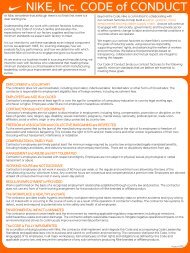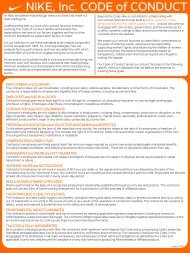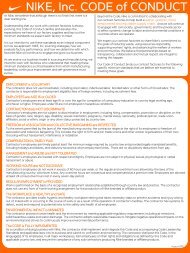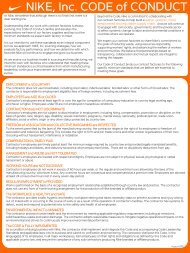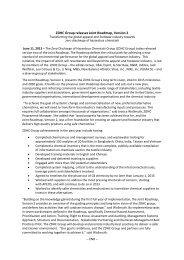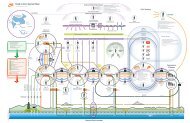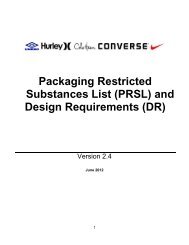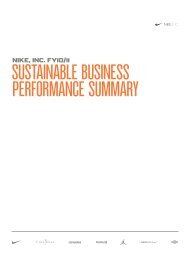COC CLS - Healthy Safety Environment - NIKE, Inc. - The Journey
COC CLS - Healthy Safety Environment - NIKE, Inc. - The Journey
COC CLS - Healthy Safety Environment - NIKE, Inc. - The Journey
Create successful ePaper yourself
Turn your PDF publications into a flip-book with our unique Google optimized e-Paper software.
BLOODBORNE PATHOGENS (DISEASES)<br />
STANDARD<br />
<strong>The</strong> contractor provides a safe, hygienic and healthy workplace setting and takes necessary steps to<br />
prevent accidents and injury arising out of, linked with or occurring in the course of work or as result of<br />
the operation of contractor’s facilities. <strong>The</strong> contractor has systems to detect, avoid and respond to<br />
potential risks to the safety and health of all employees.<br />
‣ Develop and implement processes and procedures to reduce or eliminate risk of occupational<br />
exposure to bloodborne pathogens.<br />
RESPONSIBILITIES<br />
Location Manager must ensure that the bloodborne pathogen procedures are developed,<br />
implemented and followed.<br />
HSE Representative must establish, maintain and administer risk assessment, written procedures, training,<br />
recordkeeping and annual review.<br />
Managers & Supervisors must ensure that employees are trained and adhere to the requirements as<br />
they relate to the bloodborne pathogen procedures.<br />
Employees must adhere to the requirements of the of the bloodborne pathogen procedures.<br />
DEFINITIONS<br />
• Bloodborne Pathogens are pathogenic microorganisms that are present in human blood and can<br />
cause disease in humans. <strong>The</strong>se pathogens include, but are not limited to, hepatitis B virus (HBV)<br />
and human immunodeficiency virus (HIV).<br />
REQUIREMENTS<br />
1. RISK ASSESSMENT—Each facility must have a documented bloodborne pathogen risk assessment<br />
performed which includes as a minimum:<br />
a. Identification of hazards associated with occupational exposure to bloodborne pathogens<br />
(include individuals, tasks and areas at risk of occupational exposure).<br />
b. Evaluation of the risk associated with occupational exposure.<br />
c. Identification of control measures required to reduce or eliminate risk of exposure.<br />
2. POLICIES & PROCEDURES—Each facility must have implemented procedures to reduce or eliminate<br />
the risk of occupational exposure to bloodborne pathogens which must cover as a minimum, the<br />
following:<br />
a. Prevent contact with blood or other potentially infectious materials (all body fluids must be<br />
considered potentially infectious).<br />
b. Readily available hand washing facilities and disinfectants for potential bloodborne pathogen<br />
contaminated spills.<br />
c. Personal protective equipment (PPE) available (e.g., disposable gloves, CPR guards, etc.).<br />
d. Disposal container for sharp objects (e.g., glass, blades, sewing needles, etc.) available.<br />
<strong>Safety</strong> <strong>CLS</strong> – Page 1<br />
04.14.10



